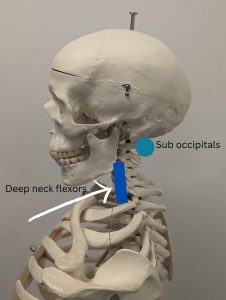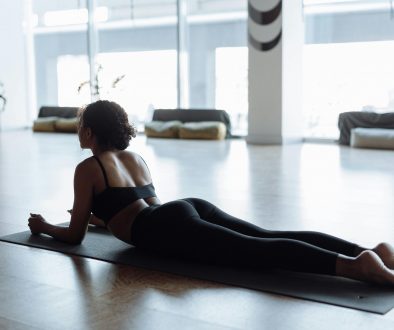6 Exercises for Neck Pain Relief
According to the National Institute for Health and Care Excellence, up to 70% of the population may experience neck pain in their lifetime. The neck may be one of the most neglected areas of our body when it comes to strengthening exercises. This is surprising as our necks hold up our heads which can weigh around 5kg. That’s more than most babies weigh at birth.
Causes of Neck Pain
We know that weak necks can cause tension headaches. The cause is often from a lack of movement or poor alignment but it could also be a result of a traumatic injury such as a whiplash injury. Even the way we breathe can also affect our neck, shoulders, upper back and chest muscles. See our “Diaphragmatic Breathing Technique” blog for more info.
Perhaps the most common cause of neck pain is “Text Neck” or “Tech Neck”. This is where a person juts their head forward for a prolonged time which piles pressure on the neck and the muscles that hold it in place. According to consumer insights firm, GWI, the “typical” global internet user spends 6 hours and 58 minutes using the internet across all devices. That is a lot of time with our necks protracted and out of alignment.
Our neck’s main function is to support the head in an aligned, neutral position. Any tilting for a prolonged time can add strain to the neck. Tilting your head out of alignment can lead to muscle imbalances as the muscles stretch and shorten to compensate in order to maintain straight-ahead vision.
Anatomy Of The Neck
Our heads are held in place by a combination of bones, muscles, tendons, and ligaments. Consequently, it has been found by research published in SAGE journals, that:
“Men and women who suffer from tension headaches had weaker neck extensor muscles and a reduced cervical extension/flexion ration compared to those who did not suffer from tension headaches”.
That is to say, some muscles become stretched and weakened, and inversely, in order to compensate some muscles become short and tight.
Stretched and Weakened Neck Muscles
- Deep cervical flexors are a group of small but important muscles that retract the neck (think of tucking the chin to give yourself a double chin).
- Erector spinae – the group of muscles that keep you upright. Contract these muscles and your back will arch. The opposite movement to a slouching spine.
- Shoulder blade retractors including the trapezius, rhomboids and latissimus dorsi. These are the muscles that pull the shoulder blades together and down the spine.

Short and Tight Neck Muscles
- Suboccipital muscles – located at the base of the back of the skull. These allow us to protract (push forward) our head for example if we are looking at something closely e.g a computer screen. If our suboccipitals are overworked, they often become a pain-generator causing a cervicogenic headache.
- Chest muscles – including the pecs and the serratus anterior below the pecs. As these muscles tighten, the shoulders become rounded forward and we slouch.
- Levator scapulae muscles. These muscles run from the top of the shoulder blade to the cervical spine to elevate the shoulder blade (think shoulder shrug). As these muscles become tight, we find ourselves in a hunched up position.
As we can see, it is not only neck muscles that are affected but also muscles in our shoulders, chest, and along our spine. So we have included stretches that target the surrounding areas too. A combination of stretching and strengthening exercises should help with current pain management and prevention of neck pain in the future.
As always, we recommend speaking to your primary care provider beforehand to make sure these exercises are appropriate and safe for you to perform. If you are looking for a chiropractor, physio or sports therapist in Cheltenham, Skelian Chiropractic Clinic can help. Just give us a call on 01242 254 000 to speak to our receptionist team or book online at skelian.janeapp.co.uk
Stretches for pain relief from a tight neck
1.) YWTL Stretch
Raise your arms in a Y shape above your head. Create space between your ears and your shoulders by drawing your shoulder blades down and together, look straight ahead and breathe deeply to feel the stretch.
Bring your arms down into a W shape, focus on drawing your shoulder blades down and together and keep your neck in a neutral position. You should feel a deep stretch in your upper back.
Now to open up your chest muscles, take your arms out to the side in a T shape.
Finally, bring your elbows into your sides and your forearms out to the sides palms facing forwards, to create the L shape. Maintain the neutral neck position and keep the shoulder blades drawn together and down.
2.) Chair stretch
Sit on a chair or kneel and clasp your hands behind your back, now gently push your chest towards the sky and look up.
3.) Doorway Chest Stretch
This can be done in a doorway or on a wall. Simply place your forearm against the wall/door frame, turn your body and head slightly away to feel the stretch in your chest muscles. Repeat on the other side.
Exercises To Strengthen Your Neck Muscles
1.) Chin Tucks (Cervical retraction)
Tuck your chin and hold for a few seconds at a time, this should build up your cervical flexors and may also release tight sub occipitals – double whammey!
2.) Scapular retraction
This is such an important and fundamental movement. It can be practised simply by drawing your shoulder blades together and down the spine. To progress this exercise, you can use a rowing machine or perform a bent over row with a dumbell.
3.) Superman
Lying on your front, engage your glute muscles and your erector spinae muscles (the ones that run along your spine). Create space between your ears and shoulders and hold your arms in front of your by squeezing your shoulder blades together.
Neck Pain Treatment
If you are suffering from neck pain, it is important to see your health practitioner. They can assess and diagnose your condition and give you a rehabilitation programme tailored to your needs.
Our team of Chiropractors, Sports therapist, and Physiotherapist are all qualified to assess and diagnose musculoskeletal conditions. At Skelian, we can offer a range of treatments to suit your requirements. If you are unsure of which practitioner to see, you can book a free chat with one of our chiropractors and they will refer you to the most appropriate practitioner. You can book online here 0r give us a call on 01242 254 000.



